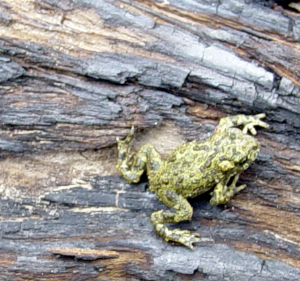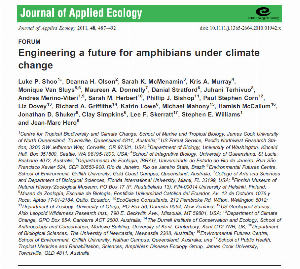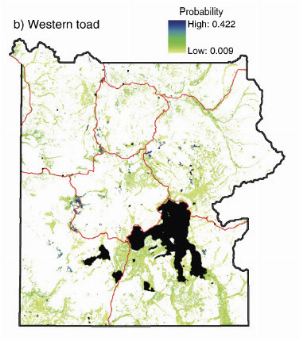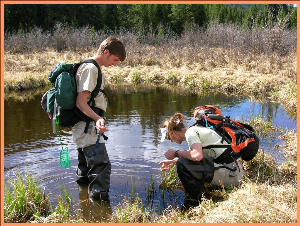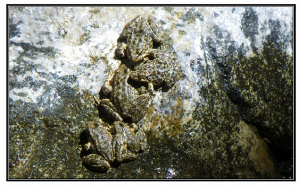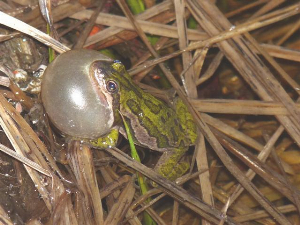Search ARMI Database
Search term(s)
Contribution Number
Search Results
879 record(s) found.
Papers & Reports Estimating occupancy in large landscapes: evaluation of amphibian monitoring in the Greater Yellowstone Ecosystem.
Authors: W R Gould; Debra A Patla; R Daley; P. Stephen Corn; Blake R Hossack; Robert Bennetts; Charles R Peterson
Date: 2012 | Outlet: Wetlands 32:379–389
Monitoring of natural resources is crucial to ecosystem conservation, and yet it can pose many challenges. We developed an amphibian monitoring program as a means for examining ecological conditions in Yellowstone and Grand Teton National Parks. Annual surveys for amphibian breeding occupancy were conducted over a 4-yr period (2006 – 2009) at two scales: catchments (portions of watersheds) and individual wetland sites. Catchments were selected in a stratified random sample with habitat quality and ease of access serving as strata. All known wetland sites with suitable habitat were surveyed within selected catchments. Changes in breeding occurrence of tiger salamanders, boreal chorus frogs and Columbia-spotted frogs were assessed using multi-season occupancy estimation. Numerous a priori models were considered within an information theoretic framework including those with catchment and site-level covariates. Habitat quality was the most important predictor of occupancy. Boreal chorus frogs demonstrated the greatest change (increase) in breeding occupancy at the catchment level. Tiger salamander breeding occurrence increased slightly and Columbia-spotted frogs decreased slightly over the 4-yr period. Larger changes for all 3 species were detected at the finer site-level scale. Use of covariates (e.g., connectivity of sites) offered improvements over simpler models, and may improve understanding of the dynamic processes occurring among wetlands within this ecosystem. Our results suggest monitoring occupancy at two spatial scales within large study areas such as ours is feasible and informative.
Papers & Reports General methods for sensitivity analysis of equilibrium dynamics in patch occupancy models.
Authors: David AW Miller
Date: 2012-05 | Outlet: Ecology 93:1204-1213
Sensitivity analysis is a useful tool for the study of ecological models that has many potential applications for patch occupancy modeling. I use the rich foundation of existing methods for Markov chain models to demonstrate new methods for sensitivity analysis of the equilibrium state dynamics of occupancy models. Estimates from three previous studies are used to illustrate the utility of the sensitivity calculations: a joint occupancy model for a prey species, its predators, and habitat used by both; occurrence dynamics from a well-known metapopulation study of three butterfly species (Hanski 1994); and golden eagle occupancy and reproductive dynamics (Martin et al. 2009a). I show how to deal efficiently with multistate models and how to calculate sensitivities involving derived state variables and lower level parameters. In addition, I extend methods to incorporate environmental variation by allowing for spatial and temporal variability in transition probabilities. The approach used here is concise and general and can fully account for environmental variability in transition parameters. The methods can be used to improve inferences in occupancy studies by quantifying the effects of underlying parameters, aiding prediction of future system states, and identifying priorities for sampling effort.
Papers & Reports Using multilevel spatial models to understand salamander site occupancy patterns after wildfire
Authors: Nathan D Chelgren; Michael J Adams; Larissa L Bailey; Richard B Bury
Date: 2011 | Outlet: Ecology 92:408-421
Studies of the distribution of elusive forest wildlife have suffered from the confounding of true presence with the uncertainty of detection. Occupancy modeling, which incorporates probabilities of species detection conditional on presence, is an emerging approach for reducing observation bias. However, the current likelihood modeling framework is restrictive for handling unexplained sources of variation in the response that may occur when there are dependence structures such as smaller sampling units that are nested within larger sampling units. We used multilevel Bayesian occupancy modeling to handle dependence structures and partition sources of variation in occupancy of sites by terrestrial salamanders (family Plethodontidae) within and surrounding an earlier wildfire in western Oregon, USA. Comparison of model fit favored a spatial N-mixture model that accounted for variation in salamander abundance over models that were based on binary detection/non-detection data. Though catch per unit effort was higher in burned areas than unburned, there was strong support that this pattern was due to a higher probability of capture for individuals in burned plots. Within the burn the odds of capturing an individual given it was present were https://2.06 times the odds outside the burn, reflecting reduced complexity of ground cover in the burn. There was weak support that true occupancy was lower within the burned area. While the odds of occupancy in the burn were https://0.49 times the odds outside the burn among the five species, the magnitude of variation attributed to the burn was small in comparison to variation attributed to other landscape variables and to unexplained, spatially autocorrelated random variation. While ordinary occupancy models may separate the biological pattern of interest from variation in detection probability when all sources of variation are known, the addition of random effects structures for unexplained sources of variation in occupancy and detection probability may often more appropriately represent levels of uncertainty.
Papers & Reports Effects of the Amphibian Chytrid Fungus and Four Insecticides on Pacific Treefrogs (Pseudacris regilla)
Authors: P Kleinhenz; Michelle D Boone; Gary M Fellers
Date: 2012-12 | Outlet: Journal of Herpetology 46(4):625-631
Chemical contamination may influence host-pathogen interactions, which has implications for amphibian population declines. We examined the effects of four insecticides alone or as a mixture on development and metamorphosis of Pacific Treefrogs (Pseudacris regilla) in the presence or absence of the amphibian chytrid fungus (Batrachochytrium dendrobatidis [Bd]). Bd exposure had a negative impact on tadpole activity, survival to metamorphosis, time to metamorphosis, and time of tail absorption (with a marginally negative effect on mass at metamorphosis); however, no individuals tested positive for Bd at metamorphosis. The presence of sublethal concentrations of insecticides alone or in a mixture did not impact Pacific Treefrog activity as tadpoles, survival to metamorphosis, or time and size to metamorphosis. Insecticide exposure did not influence the effect of Bd exposure. Our study did not support our prediction that effects of Bd would be greater in the presence of expected environmental concentrations of insecticide(s), but it did show that Bd had negative effects on responses at metamorphosis that could reduce the quality of juveniles recruited into the population.
Papers & Reports Amphibian Chytrid Fungus (Batrachochytrium dendrobatidis) in Coastal and Montane California, USA Anurans
Authors: Gary M Fellers; R A Cole; David Reinitz; Patrick M Kleeman
Date: 2011 | Outlet: Herpetological Conservation and Biology 6(3): 383:394
We found amphibian chytrid fungus (Bd = Batrachochytrium dendrobatidis) to be widespread within a coastal watershed at Point Reyes National Seashore, California and within two high elevation watersheds at Yosemite National Park, California. Bd was associated with all six species that we sampled (Bufo boreas, B. canorus, Pseudacris regilla, Rana draytonii, R. sierrae, and Lithobates catesbeianus). For those species sampled at 10 or more sites within a watershed, the percent of Bd-positive sites varied from a low of 20.7% for P. regilla at one Yosemite watershed to a high of 79.6% for P. regilla at the Olema watershed at Point Reyes. At Olema, the percent of Bd-positive water bodies declined each year of our study (2005-2007). Because P. regilla was the only species found in all watersheds, we used that species to evaluate habitat variables related to the sites where P. regilla was Bd-positive. At Olema, significant variables were year, length of shoreline (perimeter), percent cover of rooted vegetation, and water depth. At the two Yosemite watersheds, water depth, water temperature, and silt/mud were the most important covariates, though the importance of these three factors differed between the two watersheds. The presence of Bd in species that are not declining suggests that some of the amphibians in our study were innately resistant to Bd, or had developed resistance after Bd became established.
Papers & Reports Temperature, hydric environment, and prior pathogen exposure alter the experimental severity of chytridiomycosis in boreal toads
Authors: P J Murphy; S St-Hilaire; P. Stephen Corn
Date: 2011-05-24 | Outlet: Diseases of Aquatic Organisms 95:31–42
Prevalence of the pathogen Batrachochytrium dendrobatidis (Bd), implicated in amphibian population declines worldwide, is associated with habitat moisture and temperature, but few studies have varied these factors and measured the response to infection in amphibian hosts. We evaluated how varying humidity, contact with water, and temperature affected the manifestation of chytridiomycosis in boreal toads Anaxyrus (Bufo) boreas boreas and how prior exposure to Bd affects the likelihood of survival after re-exposure, such as may occur seasonally in long-lived species. Humidity did not affect survival or the degree of Bd infection, but a longer time in contact with water increased the likelihood of mortality. After exposure to ~10^6 Bd zoospores, all toads in continuous contact with water died within 30 d. Moreover, Bd-exposed toads that were disease-free after 64 d under dry conditions, developed lethal chytridiomycosis within 70 d of transfer to wet conditions. Toads in unheated aquaria (mean = 15°C) survived less than 48 d, while those in moderately heated aquaria (mean = 18°C) survived 115 d post-exposure and exhibited behavioral fever, selecting warmer sites across a temperature gradient. We also found benefits of prior Bd infection: previously exposed toads survived 3 times longer than Bd-naïve toads after re-exposure to 106 zoospores (89 vs. 30 d), but only when dry microenvironments were available. This study illustrates how the outcome of Bd infection in boreal toads is environmentally dependent: when continuously wet, high reinfection rates may overwhelm defenses, but periodic drying, moderate warming, and previous infection may allow infected toads to extend their survival.
Papers & Reports Engineering a future for amphibians under climate change
Authors: L P Shoo; Deanna H Olson; S K McMenamin; K A Murray; Monique VanSluys; M A Donnelly; D Stratford; J Terhivuo; A Merino-Viteri; S M Herbert; Phillip J Bishop; P. Stephen Corn; L Covey; Richard A Griffiths; K Lowe; M Mahony; Hamish I McCallum; J D Shuker; C Simpkins; L F Skerratt; S E Williams; JM Hero
Date: 2011-02-02 | Outlet: Journal of Applied Ecology 48:487-492
1. Altered global climates in the 21st century pose serious threats for biological systems and practical actions are needed to mount a response for species at risk.<br />
<br />
2. We identify management actions from across the world and from diverse disciplines that are applicable to minimizing loss of amphibian biodiversity under climate change. Actions were grouped under three thematic areas of intervention: (i) installation of microclimate and microhabitat refuges; (ii) enhancement and restoration of breeding sites; and (iii) manipulation of hydroperiod or water levels at breeding sites.<br />
<br />
3. Synthesis and applications. There are currently few meaningful management actions that will tangibly impact the pervasive threat of climate change on amphibians. A host of potentially useful but poorly tested actions could be incorporated into local or regional management plans, programmes and activities for amphibians. Examples include: installation of irrigation sprayers to manipulate water potentials at breeding sites; retention or supplementation of natural and artificial shelters (e.g. logs, cover boards) to reduce desiccation and thermal stress; manipulation of canopy cover over ponds to reduce water temperature; and, creation of hydrologoically diverse wetland habitats capable of supporting larval development under variable rainfall regimes. We encourage researchers and managers to design, test and scale up new initiatives to respond to this emerging crisis.
<br />
2. We identify management actions from across the world and from diverse disciplines that are applicable to minimizing loss of amphibian biodiversity under climate change. Actions were grouped under three thematic areas of intervention: (i) installation of microclimate and microhabitat refuges; (ii) enhancement and restoration of breeding sites; and (iii) manipulation of hydroperiod or water levels at breeding sites.<br />
<br />
3. Synthesis and applications. There are currently few meaningful management actions that will tangibly impact the pervasive threat of climate change on amphibians. A host of potentially useful but poorly tested actions could be incorporated into local or regional management plans, programmes and activities for amphibians. Examples include: installation of irrigation sprayers to manipulate water potentials at breeding sites; retention or supplementation of natural and artificial shelters (e.g. logs, cover boards) to reduce desiccation and thermal stress; manipulation of canopy cover over ponds to reduce water temperature; and, creation of hydrologoically diverse wetland habitats capable of supporting larval development under variable rainfall regimes. We encourage researchers and managers to design, test and scale up new initiatives to respond to this emerging crisis.
Papers & Reports Predicting breeding habitat for amphibians: a spatiotemporal analysis across Yellowstone National Park
Authors: Paul E Bartelt; A L Gallant; R W Klaver; C K Wright; Debra A Patla; Charles R Peterson
Date: 2011
The ability to predict amphibian breeding across landscapes is important for informing land management decisions and helping biologists better understand and remediate factors contributing to declines in amphibian populations. We built geospatial models of likely breeding habitats for each of four amphibian species that breed in Yellowstone National Park (YNP). We used field data collected in 2000–2002 from 497 sites among 16 basins and predictor variables from geospatial models produced from remotely sensed data (e.g., digital elevation model, complex topographic index, landform data, wetland probability, and vegetative cover). Except for 31 sites in one basin that were surveyed in both 2000 and 2002, all sites were surveyed once. We used polytomous regression to build statistical models for each species of amphibian from (1) field survey site data only, (2) field data combined with data from geospatial models, and (3) data from geospatial models only. Based on measures of receiver operating characteristic (ROC) scores, models of the second type best explained likely breeding habitat because they contained the most information (ROC values ranged from https://0.70 to 0.88). However, models of the third type could be applied to the entire YNP landscape and produced maps that could be verified with reserve field data. Accuracy rates for models built for single years were highly variable, ranging from https://0.30 to https://0.78. Accuracy rates for models built with data combined from multiple years were higher and less variable, ranging from https://0.60 to https://0.80. Combining results from the geospatial multiyear models yielded maps of ‘‘core’’ breeding areas (areas with high probability values for all three years) surrounded by areas that scored high for only one or two years, providing an estimate of variability among years. Such information can highlight landscape options for amphibian conservation. For example, our models identify alternative areas that could be protected for each species, including 6828–10 764 ha for tiger salamanders, 971–3017 ha for western toads, 4732–16 696 ha for boreal chorus frogs, and 4940–19 690 ha for Columbia spotted frogs.
Papers & Reports The importance of local and landscape-scale processes to the occupancy of wetlands by breeding wood frogs and boreal chorus frogs
Authors: R D Scherer; Erin Muths; B R Noon
Date: 2012-06-15 | Outlet: Population Ecology 54: 487-498
Variation in the occurrence and abundance of species across landscapes has traditionally been attributed to processes at fine spatial scales (i.e., local conditions), but processes that operate across larger spatial scales such as seasonal migration or dispersal are also important. Recognition of the importance of processes that operate at broad, as well as fine, scales is growing. We evaluated hypothesized relationships between the probability of occupancy in wetlands by wood frogs (Lithobates sylvaticus) and boreal chorus frogs (Pseudacris maculata) during the breeding season and attributes of the landscape measured at three spatial scales in Rocky Mountain National Park, Colorado. We also used cost-based buffers and least-cost distances to derive estimates of landscape attributes at the broader spatial scales represented by seasonal movement and dispersal. Occupancy by breeding wood frogs was associated positively with the amount of streamside habitat adjacent to a wetland and associated negatively with the cost-based distance to the nearest occupied wetland. Occupancy by boreal chorus frogs was associated positively with the number of neighboring, occupied wetlands. We found little evidence that occupancy was correlated with fine-scale attributes measured at the wetlands.
Papers & Reports New Collection Records and Range Extension for the caddisfly Arctopora salmon (Smith, 1969) (Trichoptera: Limnephilidae)
Authors: Blake R Hossack; R L Newell; D E Ruiter
Papers & Reports Ambystoma talpoideum (Mole Salamander). Oviposition Mode and Timing.
Authors: Susan C Walls; William J Barichivich; Mary E Brown
Date: 2012 | Outlet: Herpetological Review 42(4):579-580
The Mole Salamander displays geographic variation in egg deposition mode, as well as other reproductive traits. Such variation suggests the potential for genetic differentiation within this species, yet no subspecies are currently recognized. We provide additional information on the timing and mode of oviposition in A. talpoideum to aid in further understanding the geographic scope of variation in this species’ reproductive traits. In 2009, we sampled 15 ponds at St. Marks National Wildlife Refuge, Wakulla County, Florida, USA for larval and paedomorphic A. talpoideum. During a period of heavy rainfall, we observed an adult metamorphosed female A. talpoideum and a newly-deposited egg mass on 2 and 3 April 2009, respectively. To our knowledge, our observation of a new egg mass on 3 April is the latest reported date of new oviposition for this species on the Coastal Plain. In contrast to populations in the Atlantic Coastal Plain, where females deposit eggs singly, our observation also reveals that individuals of A. talpoideum in the panhandle region of Florida produce egg masses, similar to populations of this species in western parts of its range (Mississippi and Louisiana). This observation suggests that the faunal break between populations that lay eggs singly, versus those that produce egg masses, is much farther east than has been previously reported and closer to the likely geographic point of separation between populations of the two egg-laying modes. Additional information on egg-laying mode and other reproductive characteristics in Gulf and Atlantic Coastal Plain populations would be insightful for understanding the extent of geographic variation in reproduction and would help pinpoint the location of a faunal break between populations of the two egg laying modes in this species.
Papers & Reports Molecular detection of vertebrates in stream water - a demonstration using Rocky Mountain tailed frogs and Idaho giant salamanders
Authors: Caren S Goldberg; David S Pilliod; R S Arkle; L P Waits
Date: 2011-07-26 | Outlet: PLoS ONE 6(7): e22746. doi:10.1371/journal.pone.0022746
Papers & Reports Portrait of a small population of boreal toads ( Anaxyrus boreas )
Authors: Erin Muths; R Scherer
Date: 2011 | Outlet: Herpetologica
Much attention has been given to the conservation of small populations, those that are small because of decline and those that are naturally small. Small populations are of particular interest because ecological theory suggests that they are vulnerable to the deleterious effects of environmental, demographic, and genetic stochasticity as well as natural and human induced catastrophes. However, testing theory and developing applicable conservation measures for small populations is hampered by sparse data. This lack of information is frequently driven by computational issues with small data sets that can be confounded by the impacts of stressors. We present estimates of demographic parameters from a small population of boreal toads that has been surveyed since 2001 using capture-recapture methods. Estimates of annual adult survival probability are high relative to other boreal toad populations, while estimates of recruitment rate are low. Despite using simple models, clear patterns emerged from the analyses suggesting that population size is constrained by low recruitment of adults and is declining slowly. These patterns provide insights that are useful in developing management directions for this small population and this study serves as an example of the potential for small populations to yield robust and useful information despite sample size constraints.
Papers & Reports Changes in historical Iowa land cover as context for assessing the environmental benefits of current and future conservation efforts on agricultural lands
Authors: A L Gallant; Walt J Sadinski; Mark F Roth; C Rewa
Date: 2011-05 | Outlet: Journal of Soil and Water Conservation vol. 66 no. 3 67A-77A
Conservationists and agriculturists face unprecedented challenges trying to minimize tradeoffs between increasing demands for food, fiber, feed, and biofuels and the resulting loss or reduced values of other ecosystem services, such as those derived from wetlands and biodiversity (Millenium Ecosystem Assessment 2005a, 2005c; Maresch et al. 2008). The Food, Conservation, and Energy Act of 2008 (Pub. L. 110-234, Stat. 923, HR 2419, also known as the 2008 Farm Bill) reauthorized the USDA to provide financial incentives for agricultural producers to reduce environmental impacts via multiple conservation programs. Two prominent programs, the Wetlands Reserve Program (WRP) and the Conservation Reserve Program (CRP), provide incentives for producers to retire environmentally sensitive croplands, minimize erosion, improve water quality, restore wetlands, and provide wildlife habitat (USDA FSA 2008a, 2008b; USDA NRCS 2002). Other conservation programs (e.g., Environmental Quality Incentives Program, Conservation Stewardship Program) provide incentives to implement structural and cultural conservation practices to improve the environmental performance of working agricultural lands. Through its Conservation Effects Assessment Project, USDA is supporting evaluation of the environmental benefits obtained from the public investment in conservation programs and practices to inform decisions on where further investments are warranted (Duriancik et al. 2008; Zinn 1997).
Papers & Reports Compensatory effects of recruitment and survival when amphibian populations are perturbed by disease
Authors: Erin Muths; R D Scherer; David S Pilliod
Date: 2011 | Outlet: Journal of Applied Ecology
The need to increase our understanding of factors that regulate animal population dynamics has been catalysed by recent, observed declines in wildlife populations worldwide. Reliable estimates of demographic parameters are critical for addressing basic and applied ecological questions and understanding the response of parameters to perturbations (e.g. disease, habitat loss, climate change). However, to fully assess the impact of perturbation on population dynamics, all parameters contributing to the response of the target population must be estimated.
Papers & Reports Using spatiotemporal models and distance sampling to map the space use and abundance of newly metamorphosed western toads (Anaxyrus boreas)
Authors: Nathan D Chelgren; B Samora; Michael J Adams; Brome McCreary
Date: 2011 | Outlet: Herpetological Conservation and Biology 6:175-190
High variability in abundance, cryptic coloration, and small body size of newly metamorphosed anurans have limited demographic studies of this life history stage. We used line-transect distance sampling to estimate the abundance and spatial distribution of newly metamorphosed Western Toads (Anaxyrus boreas) in terrestrial habitat surrounding a montane lake in central Washington, USA. We completed 154 line-transect surveys from the commencement of metamorphosis (15 September, 2009) to the date of first snow accumulation in fall (1 October, 2009), and located 543 newly metamorphosed toads. After accounting for variable detection probability associated with the extent of barren habitats, estimates of total surface abundance ranged from a posterior median of 3880 (95% credible intervals from 2235 to 12600) in the first week of sampling to 12150 (5543, 51670) during the second week of sampling. Numbers of newly metamorphosed toads dropped quickly with increasing distance from the lakeshore in a pattern that differed over the three weeks of the study and contradicted our original hypotheses. Though we hypothesized that the spatial distribution of toads would initially be concentrated near the lake shore and then spread outward from the lake over time, we observed the opposite. Ninety-five percent of individuals occurred within 20, 16, and 15 m of shore during weeks one, two, and three respectively, probably reflecting continued emergence of newly metamorphosed toads from the lake and mortality or burrow use of dispersed individuals. Numbers of toads were highest near the inlet stream of the Lake. Distance sampling may provide a useful method for estimating the surface abundance of newly metamorphosed toads and relating their space use to landscape variables despite uncertain and variable probability of detection.
Papers & Reports Short-term response of Pacific Giant Salamanders to timber management in southwestern Oregon
Authors: N Leuthold; Michael J Adams; J Hayes
Date: 2012-01 | Outlet: Journal of Wildlife Management 76:28-37
In the Pacific Northwest, amphibians inhabit forested streams ranging from barely a trickle up to larger rivers and inhabit streams as well as the surrounding forest. Many previous studies have found a negative effect of timber management on the abundance of stream amphibians, but results have been variable and region specific. These studies have generally used survey methods that do not account for differences in capture probability, which may be important if habitat condition alter capture probabilities. In addition, most of these studies have been retrospective comparisons of stands of different ages, and focus on stands that were harvested under older management practices. Over the last 30 years forest management practices have changed substantially, yet little work examines how modern forest management relates to the abundance or density of stream amphibians. We examined the influences of contemporary forest practices on Pacific giant salamanders as part of the Hinkle Creek paired watershed study. We used a mark-recapture analysis to estimate Pacific giant salamander Density at 100 1-m segments spread throughout the basin and then used extended linear models that accounted for correlation resulting from the repeated surveys at sites across years. Density was associated with substrate, but we found no evidence of an effect of harvest. While holding other factors constant, our top model indicated; 1) each 10 percent increase in proportion of the substrate that was small cobble or larger increased median density of Pacific giant salamanders https://1.06 times, 2) each 100 hectare increase in the area drained decreased median density of Pacific giant salamander https://0.93 times, and 3) increasing the fish density in the 40 m around a site by https://0.01 increased median salamander density https://1.02 times. Our mark-recapture analysis accounted for sampling inefficiencies at sites with captures, but sites with no captures retained densities of 0 in our extended linear analysis. At least some of these sites were likely occupied and we failed to capture individuals that were present. A Monte Carlo analysis suggested that our results were not sensitive to missing captures at some sites. We did not find evidence of a short term effect of timber harvest on the density of Pacific giant salamanders at Hinkle Creek.
Papers & Reports Conservation genetics of evolutionary lineages of the endangered mountain yellow-legged frog, Rana muscosa (Amphibia: Ranidae), in southern California
Authors: S D Schoville; T S Tustall; V T Vredenburg; Adam R Backlin; Elizabeth A Gallegos; D A Wood; Robert N Fisher
Date: 2011-05 | Outlet: Biological Conservation 144:2031-2040
Severe population declines led to the listing of southern California Rana muscosa (Ranidae) as endangered in 2002. Nine small populations inhabit watersheds in three isolated mountain ranges, the San Gabriel, San Bernardino and San Jacinto. One population from the Dark Canyon tributary in the San Jacinto Mountains has been used to establish a captive breeding population at the San Diego Zoo Institute for Conservation Research. Because these populations may still be declining, it is critical to gather information on how genetic variation is structured in these populations and what historical inter-population connectivity existed between populations. Additionally, it is not clear whether these populations are rapidly losing genetic diversity due to population bottlenecks. Using mitochondrial and microsatellite data, we examine patterns of genetic variation in southern California and one of the last remaining populations of R. muscosa in the southern Sierra Nevada. We find low levels of genetic variation within each population and evidence of genetic bottlenecks. Additionally, substantial population structure is evident, suggesting a high degree of historical isolation within and between mountain ranges. Based on estimates from a multi-population isolation with migration analysis, these populations diversified during glacial episodes of the Pleistocene, with little gene flow during population divergence. Our data demonstrate that unique evolutionary lineages of R. muscosa occupy each mountain range in southern California and should be managed separately. The captive breeding program at Dark Canyon is promising, although mitigating the loss of neutral genetic diversity relative to the natural population might require additional breeding frogs.
Papers & Reports Breeding chorus indices are weakly related to estimated abundance of boreal chorus frogs
Authors: P. Stephen Corn; Erin Muths; Amanda M Kissel; R D Scherer
Date: 2011-10 | Outlet: Copeia 2011:365-371
Call surveys used to monitor breeding choruses of anuran amphibians generate index values that are frequently used to represent the number of male frogs present, but few studies have quantified this relationship. We compared abundance of male Boreal Chorus Frogs (Pseudacris maculata), estimated using capture-recapture methods in two populations in Colorado, to call index values derived from automated recordings. Single index values, such as might result from large monitoring efforts, were unrelated to population size. A synthetic call saturation index (CSI), the daily proportion of the maximum possible sum of index values derived from multiple recordings, was greater in larger populations, but the relationship was not highly predictive.
Papers & Reports Improving occupancy estimation when two types of observational error occur: non-detection and species misidentification.
Authors: David AW Miller; J D Nichols; Brett T McClintock; Evan HC Grant; Larissa L Bailey; L Weir
Date: 2011 | Outlet: Ecology
Abstract. Efforts to draw inferences about species occurrence frequently account for false negatives, the common situation when individuals of a species are not detected even when a site is occupied. However, recent studies suggest the need to also deal with false positives, which occur when species are misidentified so that a species is recorded as detected when a site is unoccupied. Bias in estimators of occupancy, colonization, and extinction can be severe when false positives occur. Accordingly, we propose models that simultaneously account for both types of error. Our approach can be used to improve estimates of occupancy for study designs where a subset of detections is of a type or method for which false positives can be assumed to not occur. We illustrate properties of the estimators with simulations and data for three species of frogs. We show that models that account for possible misidentification have greater support (lower AIC for two species) and can yield substantially different occupancy estimates than those that do not. When the potential for misidentification exists, researchers should consider analytical techniques that can account for this source of error, such as those presented here.

